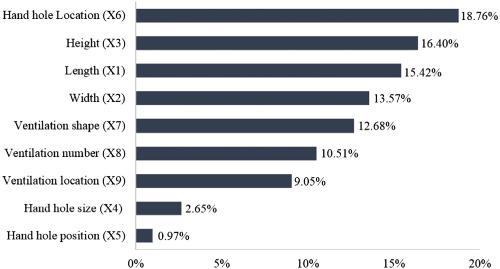当前位置:
X-MOL 学术
›
Packag. Technol. Sci.
›
论文详情
Our official English website, www.x-mol.net, welcomes your
feedback! (Note: you will need to create a separate account there.)
An analysis of the influence of hand hole and ventilation hole design on compressive strength of corrugated fiberboard boxes by an artificial neural network model
Packaging Technology and Science ( IF 2.8 ) Pub Date : 2020-02-28 , DOI: 10.1002/pts.2495 Tita Archaviboonyobul 1 , Ravipim Chaveesuk 2 , Jay Singh 3 , Tunyarut Jinkarn 1
Packaging Technology and Science ( IF 2.8 ) Pub Date : 2020-02-28 , DOI: 10.1002/pts.2495 Tita Archaviboonyobul 1 , Ravipim Chaveesuk 2 , Jay Singh 3 , Tunyarut Jinkarn 1
Affiliation

|
This research aimed at developing a high‐performing corrugated fiberboard box compression strength prediction model and to analyze the influences of ventilation and hand hole designs for these containers on the box compression test (BCT) by applying artificial neural network (ANN) modeling. The input variables considered in this study are composed of nine parameters including box dimension as well as shapes, sizes, positions, and locations of ventilations and hand holes of a regular slotted container (RSC, FEFCO 0201). Back propagation algorithms (BPNs) of ANN models were developed from 970 BCT testing data points (single wall boards, C flute, 205/112/205 g/m2). Tested data was randomly broken into three groups for the model development as 80:10:10 for the training set, testing set, and validating set. According to the analysis performed, a BPN 9‐13‐1 model reflected the highest prediction performance with R2 = 0.97. According to the analysis, BCT was significantly affected by the hand hole location followed by the geometrical dimensions of the box (height, length, and width) and the ventilation factors (shape, number, and location) in that order. Hand holes at the top flaps caused a lower BCT reduction compared with those at the vertical locations of the box. Slight changes to the eliminated board area for both hand holes and ventilation (±5%) contributed to less BCT reduction compared with its locations and shapes. Interestingly, increasing the box height significantly increased the BCT, and this was found to be limited only to shorter boxes fabricated from a high stiffness corrugated board.
中文翻译:

人工神经网络模型分析手孔和通风孔设计对瓦楞纸箱抗压强度的影响
这项研究旨在开发一种高性能的瓦楞纸箱抗压强度预测模型,并通过应用人工神经网络(ANN)建模来分析这些容器的通风和手孔设计对箱抗压试验(BCT)的影响。本研究中考虑的输入变量由九个参数组成,包括盒子尺寸以及常规开槽容器(RSC,FEFCO 0201)的形状,尺寸,位置,通风和手孔位置。ANN模型的反向传播算法(BPN)是从970个BCT测试数据点(单壁板,C槽,205/112/205 g / m 2)。对于模型开发,将测试数据随机分为三组:训练集,测试集和验证集,其比例为80:10:10。根据执行的分析,BPN 9-13-1模型反映了R 2的最高预测性能= 0.97。根据分析,BCT受手孔位置,盒子的几何尺寸(高度,长度和宽度)和通风系数(形状,数量和位置)的顺序影响很大。与箱子垂直位置的孔相比,顶部折板的手孔导致的BCT降低较小。与手孔和通风相比,消除的电路板面积的微小变化(±5%)与BCT的位置和形状相比,减少了BCT减少。有趣的是,增加盒子的高度显着增加了BCT,这被发现仅限于由高刚度瓦楞纸板制成的较短的盒子。
更新日期:2020-02-28
中文翻译:

人工神经网络模型分析手孔和通风孔设计对瓦楞纸箱抗压强度的影响
这项研究旨在开发一种高性能的瓦楞纸箱抗压强度预测模型,并通过应用人工神经网络(ANN)建模来分析这些容器的通风和手孔设计对箱抗压试验(BCT)的影响。本研究中考虑的输入变量由九个参数组成,包括盒子尺寸以及常规开槽容器(RSC,FEFCO 0201)的形状,尺寸,位置,通风和手孔位置。ANN模型的反向传播算法(BPN)是从970个BCT测试数据点(单壁板,C槽,205/112/205 g / m 2)。对于模型开发,将测试数据随机分为三组:训练集,测试集和验证集,其比例为80:10:10。根据执行的分析,BPN 9-13-1模型反映了R 2的最高预测性能= 0.97。根据分析,BCT受手孔位置,盒子的几何尺寸(高度,长度和宽度)和通风系数(形状,数量和位置)的顺序影响很大。与箱子垂直位置的孔相比,顶部折板的手孔导致的BCT降低较小。与手孔和通风相比,消除的电路板面积的微小变化(±5%)与BCT的位置和形状相比,减少了BCT减少。有趣的是,增加盒子的高度显着增加了BCT,这被发现仅限于由高刚度瓦楞纸板制成的较短的盒子。











































 京公网安备 11010802027423号
京公网安备 11010802027423号